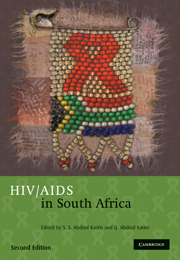Book contents
- Frontmatter
- Contents
- List of Contributors
- Foreword: Peter Piot
- Foreword: Nelson R Mandela
- Acknowledgements
- Section 1 Birth of a rapidly growing epidemic
- Section 2 The virus, the human host and their interactions
- Section 3 HIV risk factors and prevention strategiess
- Section 4 Focal groups for understanding the HIV epidemic
- Section 5 The impact of AIDS
- Section 6 Treating HIV
- 27 Tuberculosis and HIV
- 28 Prevention of opportunistic infections in adults
- 29 Nutritional prophylaxis
- 30 Challenges in managing AIDS in South Africa
- 31 Antiretroviral therapy
- 32 The challenges of implementing antiretroviral treatment in South Africa
- Section 7 What does the future hold?
- Index
27 - Tuberculosis and HIV
Published online by Cambridge University Press: 07 September 2011
- Frontmatter
- Contents
- List of Contributors
- Foreword: Peter Piot
- Foreword: Nelson R Mandela
- Acknowledgements
- Section 1 Birth of a rapidly growing epidemic
- Section 2 The virus, the human host and their interactions
- Section 3 HIV risk factors and prevention strategiess
- Section 4 Focal groups for understanding the HIV epidemic
- Section 5 The impact of AIDS
- Section 6 Treating HIV
- 27 Tuberculosis and HIV
- 28 Prevention of opportunistic infections in adults
- 29 Nutritional prophylaxis
- 30 Challenges in managing AIDS in South Africa
- 31 Antiretroviral therapy
- 32 The challenges of implementing antiretroviral treatment in South Africa
- Section 7 What does the future hold?
- Index
Summary
TUBERCULOSIS IS AN IMPORTANT GLOBAL public health threat and the burden of tuberculosis is increasing because of HIV infection. Tuberculosis is the leading cause of death among HIV-infected Africans. South Africa not only has the highest number of HIV-infected individuals in the world, but has the 4th highest burden of tuberculosis worldwide.
In individuals with early hiv infection, the presentation of tuberculosis is similar to that in hiv-uninfected individuals and is usually pulmonary. But in those with severe immunosupression, presentation may be atypical. Tuberculosis is treated in the same way in hiv-infected and hiv-unifected individuals, but care must be taken when treating hiv and tuberculosis concomitantly because of interactions between antituberculosis and antiretroviral drugs. Treatment with antiretrovirals can lead to immune reconstitution inflammatory syndrome in those coinfected with tuberculosis and hiv. dots is reducing tuberculosis transmission in many countries, but is not enough to prevent the incidence of tuberculosis rising in areas of high hiv prevalence. What is needed are efforts to reduce tuberculosis transmission through active case finding and by preventing reactivation of latent tuberculosis through preventive therapy.
Tuberculosis (tb), a curable and preventable disease, remains an important public health threat globally. Approximately one third of the world's population is infected with Mycobacterium tuberculosis. In sub-Saharan Africa and globally the burden of tuberculosis has peaked and is starting to decline. An estimated 68% of all individuals who are co-infected with hiv and M tuberculosis (mtb/hiv co-infection) live in sub-Saharan Africa.
- Type
- Chapter
- Information
- HIV/AIDS in South Africa , pp. 457 - 478Publisher: Cambridge University PressPrint publication year: 2010



